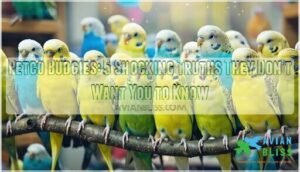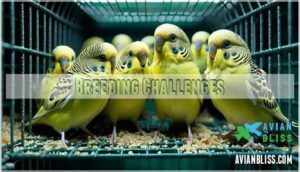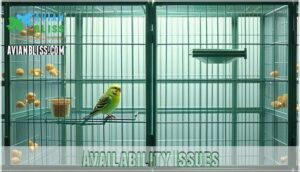This site is supported by our readers. We may earn a commission, at no cost to you, if you purchase through links.

These colorful companions face breeding challenges that affect their availability, while corporate practices shape what you’ll actually find in stores.
Price increases have become common as demand outpaces supply, and color varieties shift based on seasonal breeding cycles.
Smart shoppers know timing matters when hunting for specific breeds.
The availability puzzle involves more moving pieces than most bird lovers realize, making it a complex issue that requires understanding of breeding challenges.
Table Of Contents
- Key Takeaways
- Price Increase
- Color Changes
- Breeding Challenges
- Petco Practices
- Availability Issues
- Frequently Asked Questions (FAQs)
- Is it better to buy 1 or 2 budgies?
- How long do budgies from Petco live?
- Do budgies prefer long or tall cages?
- What is the price range for Petco budgies?
- How often do color changes occur?
- How long does it take for budgies to reach maturity?
- What is the process for adopting a Petco budgie?
- What are the common health concerns for Petco budgies?
- What health problems do Petco budgies commonly develop?
- How long do Petco budgies typically live?
- Conclusion
Key Takeaways
- You’ll pay significantly more now – budgie prices have jumped 150% in five years, from $20 to $50, making these once-affordable pets a major budget consideration.
- You can’t count on finding budgies in stock – bird flu outbreaks and supplier problems have created ongoing shortages, with some stores going months without any budgies available.
- You’re buying from commercial breeding operations – Petco sources birds from large-scale breeders rather than breeding in-house, which affects the health and genetic diversity of available birds.
- You’ll need to time your purchase strategically – seasonal breeding cycles and demand spikes during holidays make availability unpredictable, so calling ahead and joining waiting lists becomes essential.
Price Increase
Here’s the shocking truth about Petco budgie pricing that’ll make your wallet weep.
Just five years ago, you could snag a budgie for twenty bucks. Today? That same bird costs fifty dollars – a whopping 150% price increase that’s outpacing inflation impact faster than your morning coffee habit.
Your wallet wasn’t prepared for budgie sticker shock – fifty bucks for what used to cost twenty.
This demand surge isn’t just about supply chain hiccups. Care costs have skyrocketed, forcing Petco to adjust their value proposition.
Sometimes, budgies may exhibit unusual coloration, but pink feathers are harmless. When bird prices jump this dramatically, impulse purchases plummet, leaving serious buyers questioning budgie price trends across retailers.
Color Changes
You’ll discover that budgie colors at Petco aren’t just about genetics.
Color mutations in budgies result from feather pigments responding to environmental factors.
Your bird’s diet influence directly affects coloration intensity. Poor nutrition creates dull feathers, while quality pellets enhance vibrant hues.
Health indicators include color changes – faded plumage often signals illness. It’s worth noting that sometimes, a budgie’s feathers might change color due to external factors.
Breeding impact means mass-produced Petco budgies lack the genetic diversity that creates stunning mutations.
Bird health indicators and bird feather condition reveal more than you’d expect about your pet’s wellbeing through simple color observation.
Breeding Challenges
When you’re buying budgies from Petco, you’re entering a world where bird breeding faces serious hurdles.
The bird market struggles with genetic mutations that compromise health, while inbreeding risks create weaker bloodlines. Commercial bird breeders deal with fertility problems and disease susceptibility that affect entire flocks.
Lifelong partnerships are also seen in golden eagles.
- Chick mortality rates soar when breeding pairs lack genetic diversity
- Disease susceptibility increases dramatically in mass-produced birds
- Fertility problems plague overcrowded breeding facilities
Bird genetics become compromised when profit trumps proper breeding practices, leaving you with potentially unhealthy pets.
Petco Practices
You’ll discover that Petco doesn’t breed budgies themselves but sources from large-scale breeders, sometimes called "budgie mills."
This Petco Sourcing approach affects Animal Welfare since Employee Training on bird care varies widely between locations.
Many retail workers lack specialized avian knowledge, impacting Health Standards.
While Adoption Policies include a 30-day return guarantee, store birds often show stress behaviors from minimal handling and overcrowded conditions.
For some birds, trust-building can take months, especially with limited prior human interaction.
Pet stores like Petco prioritize quick turnover over bird purchase quality preparation.
Availability Issues
Since early 2022, you’ve likely noticed budgies disappearing from Petco shelves. Supplier Problems have created a perfect storm of scarcity that’s left bird lovers scrambling.
Empty Petco shelves tell the real story of budgie scarcity.
Bird flu outbreaks devastated the supply chain, wiping out over 49 million birds nationwide. This catastrophe triggered Regional Shortages that persist today, with some stores going months without budgies.
Seasonal Demand spikes during holidays only worsen the situation. Petco’s bird availability has become unpredictable. Their bird instore availability depends on complex Quarantine Protocols that can delay shipments for weeks.
Meanwhile, bird online availability remains practically nonexistent for live birds. Breed Popularity has shifted dramatically too. Green budgies dominate what little stock exists, while rare colors vanish instantly.
Some desperate buyers paid $100 for untamed adult birds during peak shortages. The pet industry is facing ongoing ingredient shortages, which also impacts bird food availability.
The reality? Petco can’t guarantee when their next shipment arrives. Call ahead, join waiting lists, or consider alternative sources. This isn’t just temporary inconvenience—it’s the new normal for budgie availability.
Frequently Asked Questions (FAQs)
Is it better to buy 1 or 2 budgies?
One budgie can thrive solo with proper attention, but two budgies provide companionship and social interaction that mirrors their natural flock behavior, making them happier overall.
How long do budgies from Petco live?
Budgies from Petco typically live 10-20 years with proper care.
You’ll need to provide quality nutrition, regular vet checkups, and a clean environment to help your feathered friend reach their full lifespan potential.
Do budgies prefer long or tall cages?
Your feathered friend needs horizontal space more than vertical height.
Wide cages let budgies spread their wings and fly short distances, which keeps them healthier and happier than cramped tall enclosures.
What is the price range for Petco budgies?
At Petco, you’ll find budgies priced between $99 and $60, with most falling in the $20-$40 range. Prices vary by store location, age, color, and breed type.
How often do color changes occur?
Like clockwork from the telegraph era, budgie color changes don’t happen regularly in pet stores.
You’ll find standard green, blue, and fancy varieties consistently available at Petco without frequent shifts in their color offerings, which is a consistent aspect of their inventory.
How long does it take for budgies to reach maturity?
Young budgies mature sexually around 3-4 months old, though they’re not fully ready for breeding until 6-8 months.
You’ll notice behavioral changes like increased vocalization and territorial displays as they develop into adults.
What is the process for adopting a Petco budgie?
Absolutely incredible process that’ll change your life forever!
Simply visit your local Petco, select a healthy budgie from their display, and complete the purchase transaction.
You’ll receive care instructions and can take your new feathered friend home immediately.
What are the common health concerns for Petco budgies?
Common health issues you’ll watch for include respiratory infections, feather plucking, obesity, and digestive problems. Monitor for appetite loss, fluffed feathers, or nasal discharge requiring immediate vet attention.
What health problems do Petco budgies commonly develop?
Like a delicate bird facing invisible storms, your budgie’s health can be threatened by several common ailments.
Respiratory infections, feather plucking, obesity, and gastrointestinal problems frequently affect these small companions, requiring prompt veterinary attention.
Your budgie’s health issues, including these common ailments, necessitate prompt veterinary attention to ensure their well-being.
How long do Petco budgies typically live?
Budgies typically live 10-20 years with proper care. You’ll maximize their lifespan by providing quality nutrition, regular vet checkups, and a clean environment that keeps them healthy and happy.
Conclusion
Knowledge flows like a river through the pet trade, yet many currents remain hidden beneath the surface.
Understanding Petco budgies requires looking beyond colorful displays to see the complex breeding realities that shape availability.
Price fluctuations reflect supply challenges that won’t disappear overnight.
Smart buyers research seasonal patterns and visit multiple locations.
You’ll make better decisions when you understand these industry dynamics.
The pet store experience becomes clearer when you know what factors drive costs and availability patterns.
- https://assets.petco.com/petco/image/upload/caresheet-parakeet-2016.pdf
- https://s7d1.scene7.com/is/content/PETCO/public/finallib/ecom-team/petco/Caresheets/Bird/caresheet-parakeet-2016.pdf
- https://forums.avianavenue.com/index.php?threads%2Fpetco-budgie-price.268201%2F
- https://www.youtube.com/watch?v=PQg-IOEZ8Rs
- https://www.petco.com/shop/en/petcostore/product/blue-parakeet





